by Ocean Robbins: Squash: it’s a racquet game, an unfortunate fate for a bug, and one of nature’s most varied, delicious, and generous foods…
If you’ve ever successfully grown squash in your garden, you probably know the meaning of the word “abundance.” But even if you’re a squash lover, there are likely dozens of varieties you’ve never tried. Let’s take a closer look at the health benefits of this versatile, beautiful, and incredibly healthy food.
Every so often, the world brings squash to the center of our attention. If you live in the US, it’s hard to avoid “pumpkin-spice” mania during the winter holiday season. A stroll in a farmers market in the fall will bring you face to face with gourds of all shapes, sizes, colors, and textures. And for a backyard gardener, late summer is the time when we desperately search for recipes to handle the bonanza of zucchini that we can’t even give away.
While pumpkins, zucchini, and decorative gourds capture our imagination, they represent a tiny fraction of the world of squash. There are over 100 varieties of squash, comprising two main categories: summer and winter. Winter squash are further divided into edible and inedible, with the latter serving both decorative and functional purposes. Of course, if you’re unfamiliar with the wide variety of winter squash, you might be missing out on some of the most delicious and nutritious foods simply because you mistake them for table ornaments. Let’s dive into these versatile veggies and examine some of the health benefits of squash.
Where Did Squash Originate?
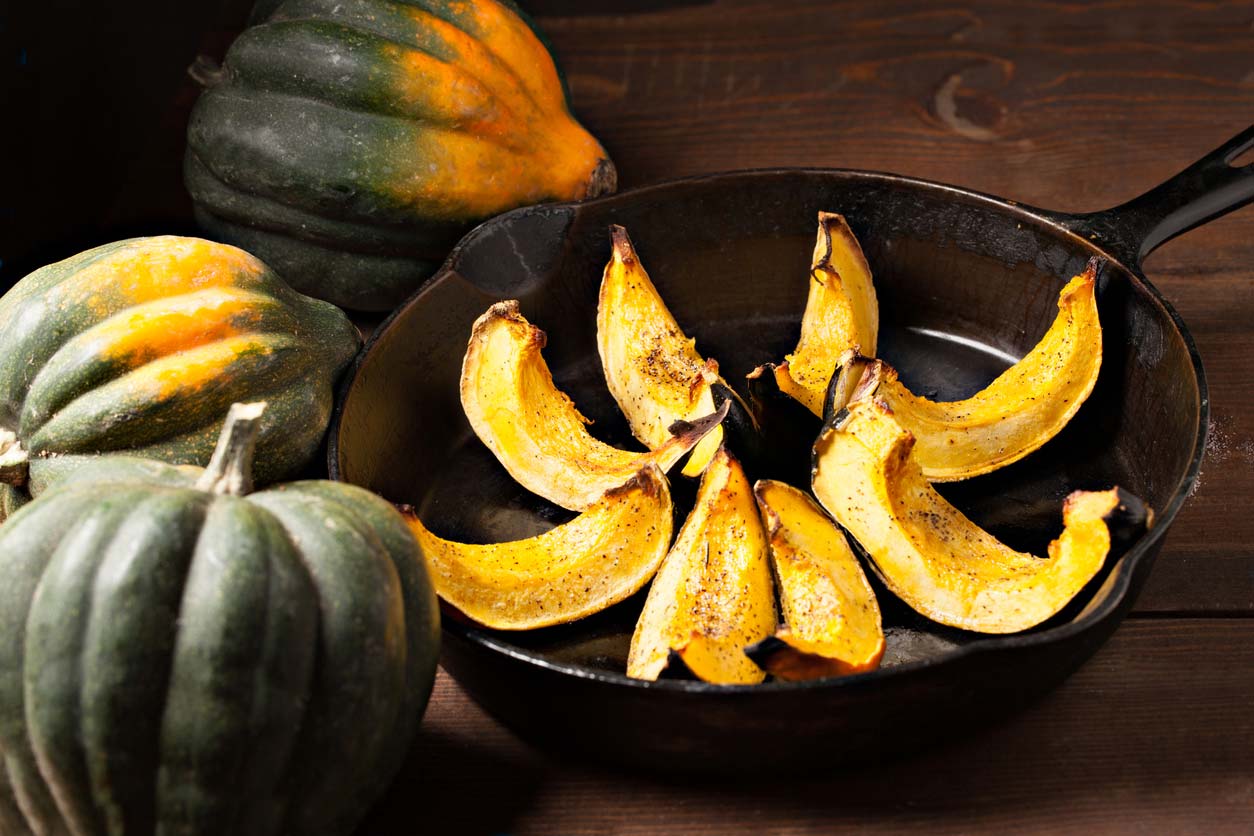
The word “squash” comes from the Narragansett Native American word askutasquash, which means “eaten raw or uncooked.” This is because there are many kinds of squash, such as zucchini, that could safely be consumed without cooking. But whether eaten raw or cooked, the flesh and seeds provided carbohydrates, healthy fats, and a rich source of micronutrients. The hard-rinded winter squash could also be hollowed out and dried, and then used to transport water or other food.
The first wild squash appeared in Mexico around 100,000 years ago. And they have been cultivated for more than 8,000 years, making them one of the world’s oldest domesticated crops. Wild varieties spread north to what is now the central United States, and as far south as Argentina. About 20 species of wild squash grow in this range, which encompasses temperate and tropical regions. All squash are members of the Cucurbitaceae family of the genus Cucurbita.
From five of these species (in case you’re training for Jeopardy’s “Agriculture Trivia” category) — C. argyrosperma, C. ficfolia, C. maxima, C. moscha and C. pepo — came the hundred-plus varieties we enjoy today. You can find tan, orange, green, blue, yellow, and white squash — solid colored and with stripes.
Squash Types
The basic kinds of squash are known as summer and winter squash. Summer squash tend to be smaller (although if you grow zucchini and forget to harvest for a couple of days, be prepared for fruit the size of toddler’s legs!) and are eaten before the rinds and seeds begin to harden. Winter squash take longer to grow, are less symmetrical, and have hardened rinds that are either smooth or rough-textured.
Pumpkins are the most famous type of winter squash. Most pumpkins are bred for decorative (hello jack o’lanterns!) rather than edible purposes. But, of course, you can make wonderful pumpkin pies, breads, soups, and other hearty fall delicacies from these big, orange winter vegetables. Surprisingly, most canned “pumpkin” isn’t pumpkin at all, but other varieties of winter squash such as Delicious and Boston Marrow.
Gourds are winter squash grown primarily for decorative and storage purposes, as they have hard shells and unpalatable or even inedible flesh. Gourds make lovely birdhouses, bowls, and percussion instruments.
Here are some of the most popular edible squash varieties:
Winter Squash

Spaghetti squash
These are yellow, oblong squash whose flesh form into spaghetti-like strands when cooked. They’re great as a pasta substitute, baked and topped with tomato sauce and plant-based parmesan, or halved and roasted to give them a nuttier taste.
Butternut squash
These are the longevity all-stars of the squash world. After harvesting, store them in a cool, dark place that has just the right amount of humidity, and they’ll overwinter like champs, lasting 3-6 months or even longer. You can peel, cube, and steam the flesh to make creamy and rich soups and stews. Or slice and roast them with herbs to enjoy butternut squash rings.
Acorn squash
These are, as you might have surmised, shaped like giant green acorns. Small enough to be the centerpiece of a meal for two, acorn squash is awesome baked or roasted. They have a sweet note that can be enhanced by drizzling some cinnamon and maple syrup over the flesh before cooking.
Sugar pumpkins
These are just smallish versions of the classic orange pumpkin. If you’ve ever carved a large orange pumpkin, you know that the flesh can be bland, hard, and fibrous — three adjectives rarely used by admiring chefs. Sugar pumpkins have softer, sweeter flesh that cooks well and offers a lot of flavor and color to holiday dishes.
Carnival squash
Carnival squash is a variety of the adorably-named dumpling squash clan. If you can get a carnival to grow in your garden, prepare for an inundation of fruit. They’re roundish with lovely markings and are great baked, steamed, sliced on the grill, or stuffed.
Banana squash
These are given the heroic name Cucurbita maxima, are related to pumpkins and have absolutely nothing in common with bananas except perhaps a vague resemblance in shape. You can slice them into rings or cubes, and use them as you’d use butternut or any other winter squash.
Summer Squash
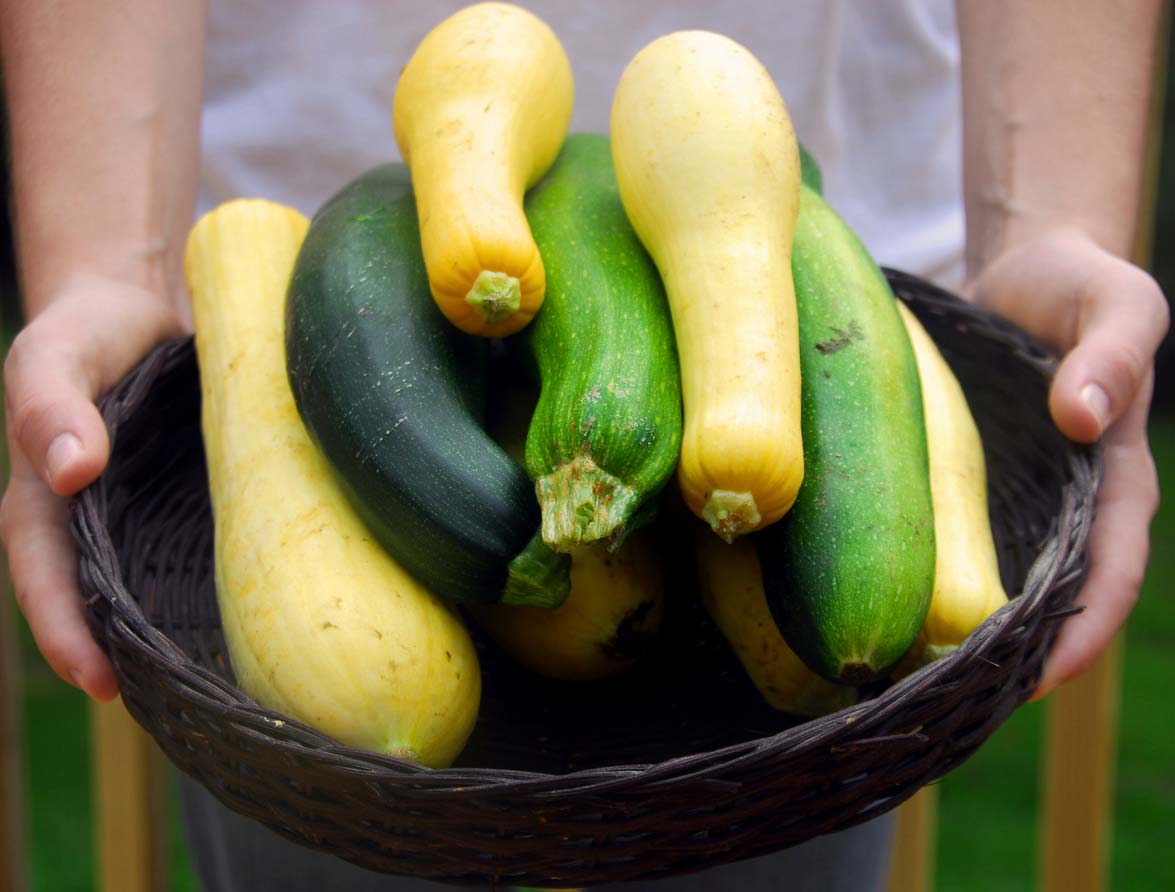
Zucchini
Zucchini are long, green summer squash that can range in size from that of a small banana to Popeye’s forearm. They’re all the same plant. The only difference in the size of the fruit is how long they spend on the vine. Given enough sun and rain, and decent soil, a zucchini fruit can grow freakishly large if the gardener isn’t checking daily. Zucchini is really versatile. You can eat them raw (spiralized, they become zoodles, which, thankfully, isn’t also the name of a dog breed), sauteed with basil, stuffed in boat form, breaded and air-fried, grilled in a pan, or pureed in a soup.
Yellow squash
These are zucchini’s yellow cousins. Same shape, similar taste, and similar culinary uses. If you have access to both zucchini and yellow squash, combining them in a dish adds a splash of color that can turn ordinary into festive.
Crookneck squash
These are yellow squash that have thin handles, and look a little like maracas. Prepare them like other summer squash: sauteed, steamed for salads, and in casseroles, as well as in soups and stews, or throw them on a summer grill.
Calabacitas
Spanish for “little squash,” and also known as Mexican squash, Calabacitas come in two shapes: the slender zucchini and the roly-poly round squash. Use it as you would any other summer squash.
Squash Nutrition
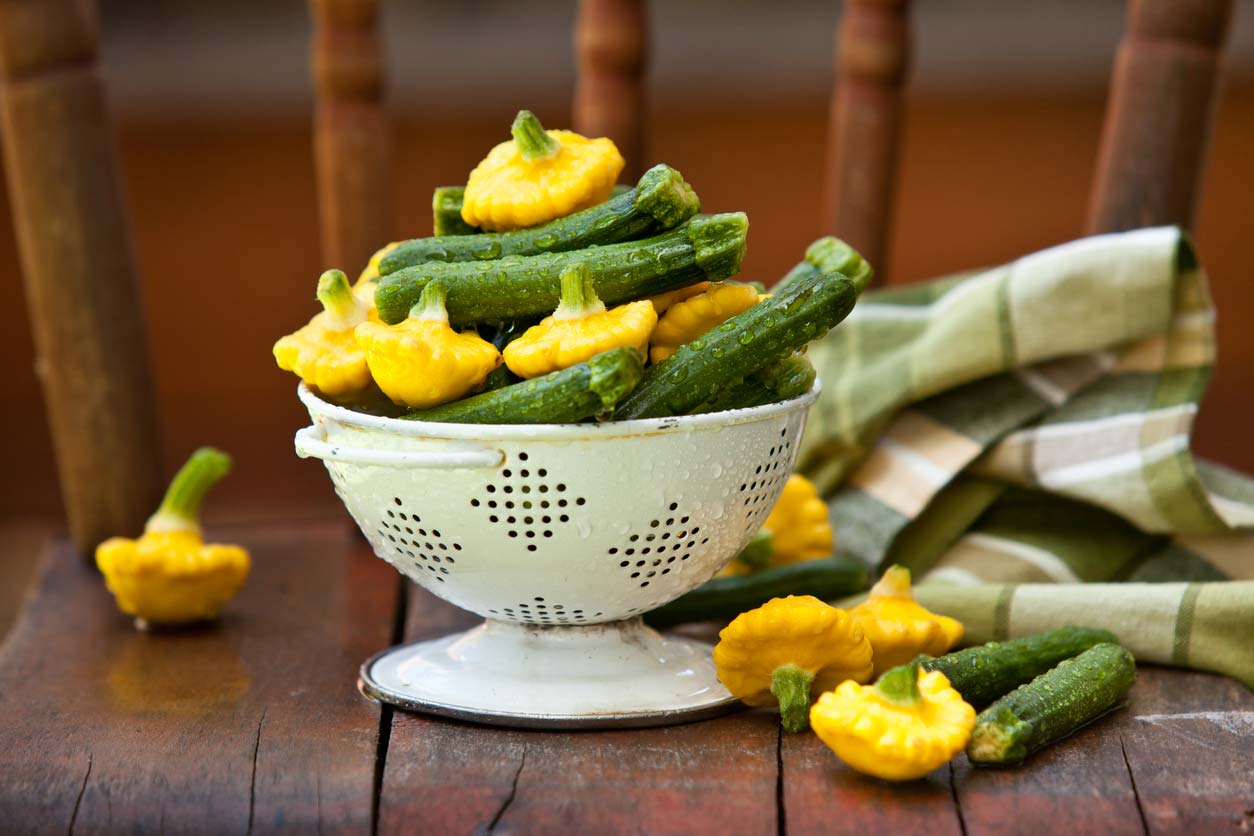
While each squash variety boasts a slightly different nutritional profile, they share several strong health benefits. Squash are good sources of vitamin A, C, and B vitamins; they’re high in antioxidants; and they’re rich in minerals such as potassium, magnesium, and manganese. And, of course, as whole plant foods, they’re also rich in fiber and water, making them both hydrating and good for the gut.
Health Benefits of Squash

Squash are high in antioxidants, particularly beta-carotene, vitamin C, and polyphenols. These nutrients help our bodies fight a number of chronic diseases, including type 2 diabetes, cardiovascular disease, and certain cancers. Higher circulating levels of beta-carotene, in particular, have been shown to reduce all-cause mortality.
1. Good for Your Eyes
Eating squash regularly can keep your vision keen too. The beta-carotene and lutein in squash, as well as vitamin C and other antioxidants and anti-inflammatories, are good for the eyes and can help prevent cataracts and macular degeneration.
2. Good for Your Heart
Squash can keep your heart ticking through their abundant supply of carotenoids, which can help lower blood pressure, reduce inflammation, and downregulate the expression of specific genes linked to heart disease. A 2016 analysis of a data set from rural China in the 1980s found that the more fruits and vegetables people ate, the more they were protected from heart disease, as well as gastric cancer and stroke. And yellow and orange squash, in particular, were linked to avoidance of these diseases.
3. Good for Balancing Blood Sugar
Banana squash have traditionally been used as hypoglycemic treatments in northwest Iran as well as China and Mexico. Researchers in Iran tested the power of banana squash to control blood glucose in critically ill diabetic patients. They gave the patients twice-daily doses of powdered banana squash for three days and measured blood glucose and the amount of insulin each patient required. Within 72 hours, the patients’ average blood glucose had dropped from 215 to 178 mg/dl, while insulin requirements decreased around 20%. The study, published in 2018, concluded that the powdered banana squash was a “fast and effective” treatment for critically ill diabetic patients.
4. Good for Your Hair and Skin
Squash should also be on the menu if you want healthy hair and skin. Several compounds found in squash, most notably beta-carotene, are associated with a healthy dermal (skin) microbiome.
5. Cancer-Fighting Compounds
The health benefits of squash varieties like zucchini are myriad: they contain many bioactive compounds that fight cancer. And they do it in multiple ways: from combatting genotoxins (toxic agents that damage DNA molecules and cause mutations and tumors) and cytotoxins (compounds that damage all cells, pretty much indiscriminately), to triggering programmed cell death in damaged cells that might otherwise turn cancerous (a process known as apoptosis).
GMO Squash
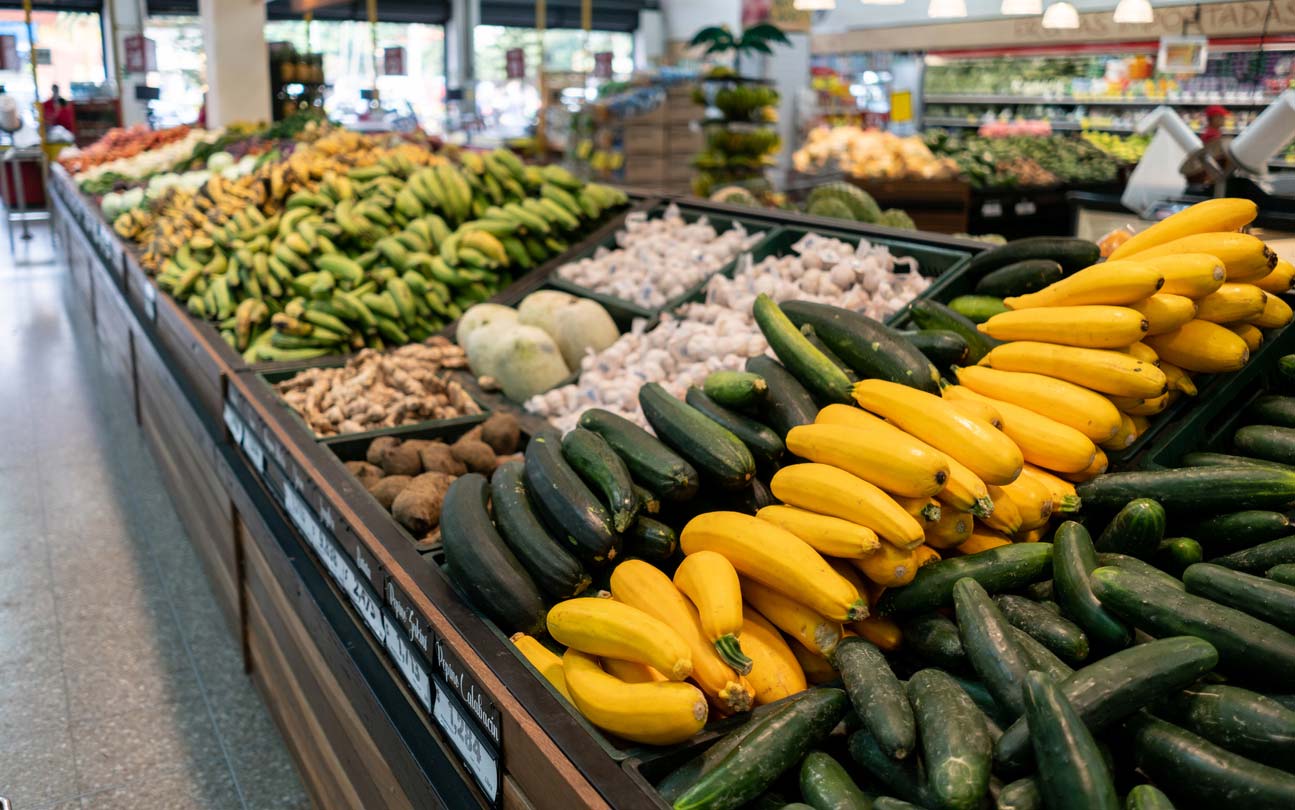
Despite the myriad health benefits of some squash, some of the zucchini and yellow squash grown in the US are genetically modified. GMO squash accounted for about 12% of summer squash sold in the US in 2005, and in some rare good news for skeptics of GMO agriculture, that number appears to be dropping. In 2017, the US Department of Agriculture estimated that American farmers grew about 2,500 acres of genetically modified or otherwise bioengineered summer squash, out of a total harvest of 37,000 acres. The varieties to look out for include green zucchini, yellow straight-neck, and yellow crookneck squash. While not typically awash in pesticides, summer squash has nevertheless made it onto the Environmental Working Group’s 2020 Shopper’s Guide to Pesticides in Produce.
Winter squash may also be sprayed with pesticides, so it’s best to buy your squash organically grown whenever possible. Ideally, you might be able to get your zucchinis and butternuts from a small farm, local CSA, or farmers market. Or even better — grow them yourself.
How to Grow Squash
Both summer and winter squash are among the easiest foods to grow, and both produce prolifically. Chances are, you’ll end up giving away a lot of summer squash, and need a fair amount of storage space for winter squash. Want to know how to grow squash? Click here for some tips.
How to Choose & Store Squash

Whether you’re growing or buying zucchini or yellow squash, look for fruits around six to eight inches long. If you’re getting a scalloped variety such as patty pan, you want them three to six inches in diameter. If the skin is too hard to be marked by a thumbnail, it’s too old to use and should be composted or thrown away. You should store summer squash in the vegetable crisper of the refrigerator for no more than four days (check out the cooking suggestions and recipes below for lots of inspiration to use them quickly). You can also freeze summer squash for use in breads and soups. Remove the peel, cut them into slices or cubes, and drop in boiling water for three minutes — followed by three minutes in ice water. Drain the squash, and pack it in freezer-friendly containers for later use.
When selecting winter squash, look for fruits without soft spots, bruises, or mold. Choose one that feels heavy for its size. Don’t worry about little bumps or discolorations of the rind, these are normal. Winter squash lasts far longer than summer squash: up to 3 months at room temperature, and twice that or more in a cellar, or another environment that’s dark, dry, ventilated, and cool (50-55 degrees Fahrenheit). Don’t wrap the squash in plastic, as they need to breathe. Once you cut into a winter squash, don’t store it open in the fridge, unless you can put it in a crisper drawer or paper bag to prevent it from drying out.
Best Ways to Prepare Squash
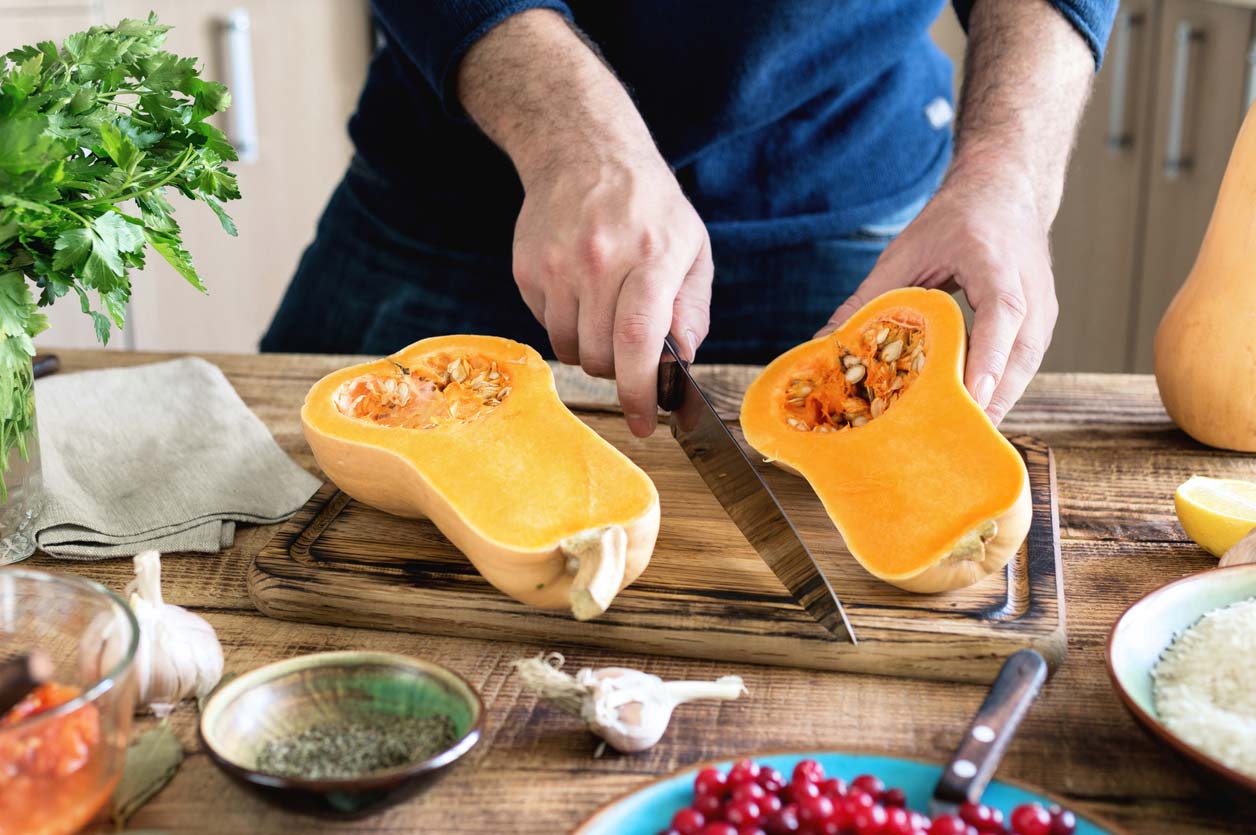
Squash is incredibly healthy and versatile and goes well in lots of dishes — and with many different cooking methods. You can bake, roast, or steam winter or summer squash, or water saute it with herbs to bring out its nutty flavor. Summer squash is also great on the grill. Winter squash can grill as well, but it’s better to steam it first so the outside doesn’t scorch before the inside is cooked.
Squash can flavor, bulk up, and provide texture and variety in soups and stews. You can leave it in chunks, or puree it. If you have picky eaters to feed, you can hide healthy squash in homemade tomato sauces. Fresh summer squash, raw or steamed, is a great addition to salads. And baked winter squash cubes can provide intense flavor, chewiness, and even some crunch to a hearty winter salad. Summer squashes can balance out the notes of eggplant and tomato in ratatouille, making it acceptable to less adventurous palates. Butternut squash and zucchini both work well as a pasta too if you put them through a spiralizer. Winter squash can be pureed and used in baked goods and pies, just as you’d use a can of pumpkin pie filling.
When it comes to squash, there’s practically no end to the ways you can prepare and enjoy this wonderful, prolific, and beautiful food. For immediate inspiration, and to reap the health benefits of squash, here are three recipes to get you started.
3 Healthy Squash Recipes
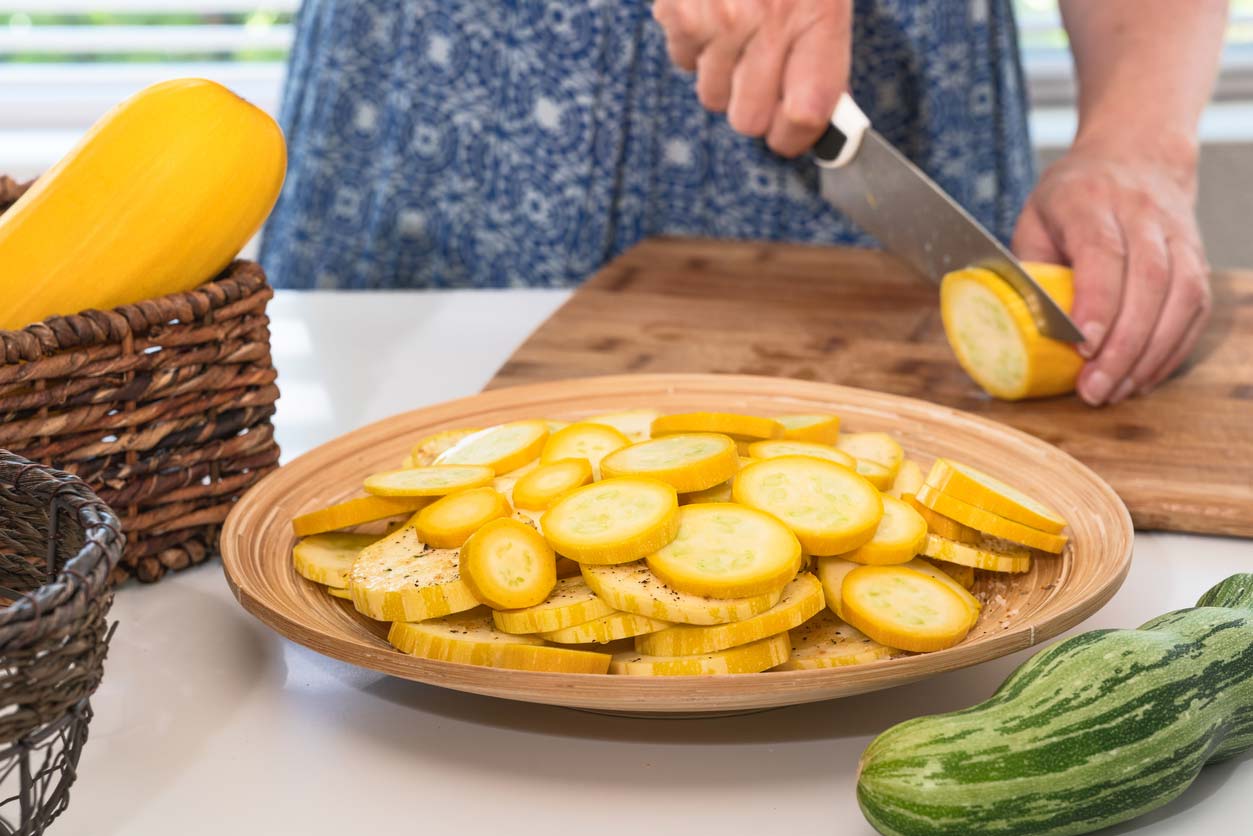
Now that you have a whole new appreciation for squash, in all its versatile and nutrient-dense beauty, it’s time to eat some! It can be enjoyed baked, grilled, steamed, or even (for summer squash) raw. It can also be combined with lots of other ingredients because of its neutral flavor. Use it often, and especially in these Food Revolution Network recipes. Let us know how you love to enjoy squash!
Raw Zucchini Cannelloni
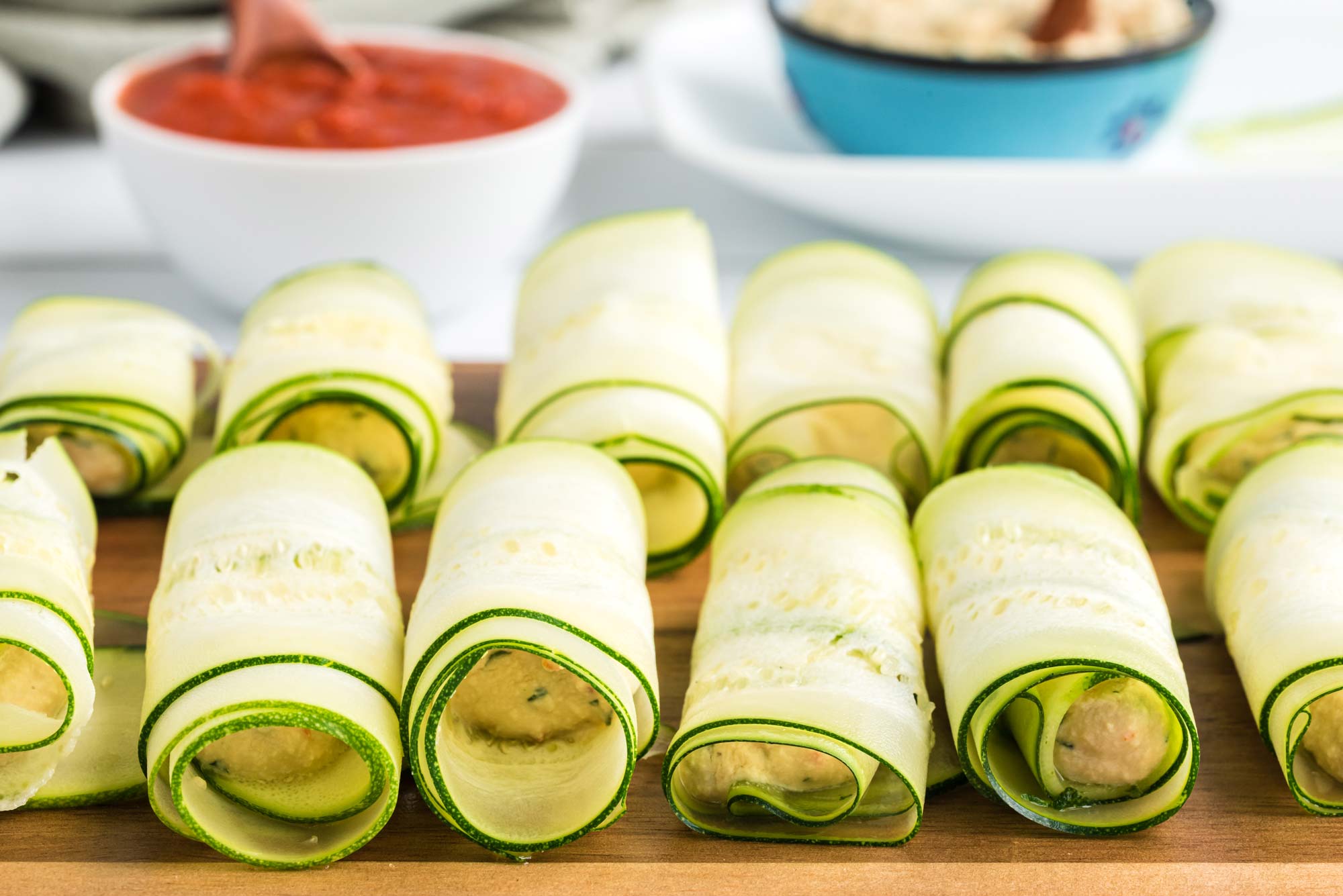
Want to impress your guests? This is the simplest appetizer recipe once your Herbed Cashew Cheese is prepared (which is also super easy!). But it’ll look and taste like it took you days to make!
Southwest Veggie Burgers

These Southwest Veggie Burgers are a great example of how you can sneak vegetables into any picky eater’s diet. Even though neither they nor you will notice the squash, it’s playing an essential binding role with its fiber and moisture – not to mention the nutrients it brings to the table!
Cheesy Squash Casserole
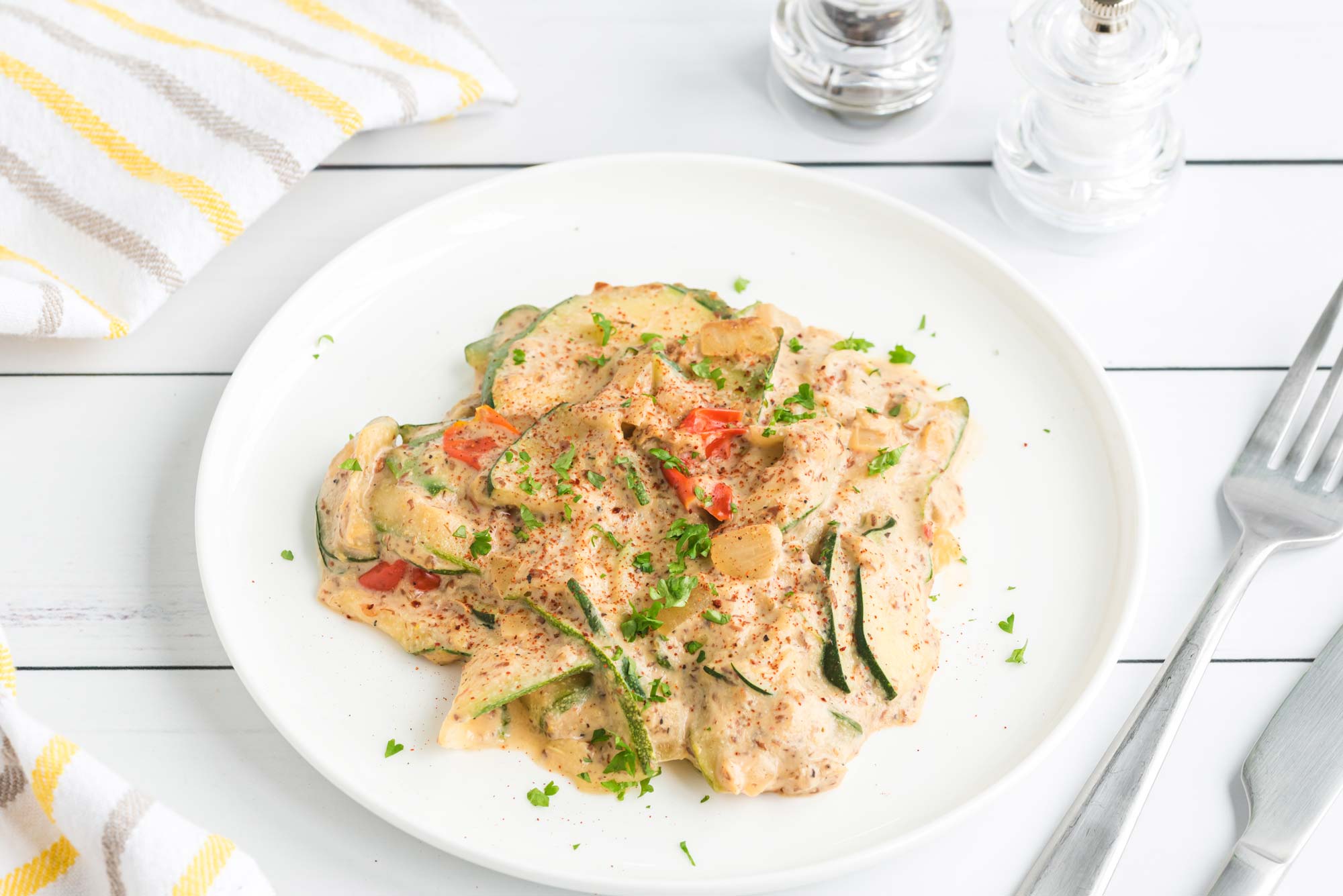
There’s no hiding it, squash is the star of the show here — and for good reason! It makes a delicious casserole combined with other vegetables, cashew cheese, and fresh herbs. Enjoy it with summer squash during the spring and summer and butternut squash during the fall and winter.
The Wonders of Squash

Squash is a key player in many culinary traditions around the world — and an easy-to-grow nutritional superstar. With so many different varieties of both summer and winter squash, there’s no shortage of ways to enjoy adding more squash to your diet. In addition to being delicious, squash is rich in vitamins and phytonutrients that are good for your eyes, your heart, and your cells. It’s also relatively easy to grow, providing a rich source of nourishment for minimal time and monetary investment. Experiment with different types of squash, and give these recipes a try!

















































